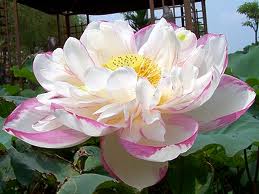





“I have quite a large natural pond that is at least 90cm (36in) deep in the centre, and I would like to plant it with waterlilies. What varieties should I use and how should I plant them?”
 The ordinary aquatic planting baskets are inadequate, and would seem to be pointless, given that the floor of the pond is earth.
The ordinary aquatic planting baskets are inadequate, and would seem to be pointless, given that the floor of the pond is earth.
It is important to choose waterlilies that will enjoy the depth of water in your pond, and which can be readily identified, for in an earth-bottomed pond, they may grow into one another. Select varieties such as Nymphaea ‘Gladstoneana’ for the very deep areas, and the likes of Nymphaea ‘Marliacea Chromatella’ for the shallower parts. Each of these varieties has very distinct foliage, so if they grow into one another, they can be separated easily.
The easiest method of planting natural areas is to carefully place the waterlilies by hand or, if the water is too deep, gently lower them from a boat. Cut all the foliage from each bare-rooted waterlily, leaving a tuft of submerged leaves on the nose. Wrap the plant in a 30cm (12in) square of hessian, with a generous quantity of soil, and tie around the plant. Then place into the water. Eventually, the hessian wrapping will rot, but in the meantime, the roots will grow out and invade the surrounding soil, leading to the formation of large waterlily colonies.
“I have substantial groups of reedmace growing along the banks of my pool. They are most attractive and wonderful for wildlife, but they are also very invasive and grow into adjacent plants. Unfortunately, the pool is lined, and although there is a good depth of soil over the liner, I am reluctant to use a spade to dig them out, as I may damage it.”
There are two possible solutions to your problem. The first is to cut the reedmace to below water level during late summer in those areas where it is a nuisance. The hollow stems will fill with water and, in most cases, the plant will rot away. Sometimes, the main terminal growth beneath the water may continue to develop, but usually very weakly.
You could also use a herbicide, in which glyphosate is the active ingredient. This is a systemic weedkiller that is absorbed by green foliage and taken into the sap stream, killing the plant from within. Thus, it is harmless to everything except green living plants. Even fish and aquatic insect life are completely unharmed by glyphosate.
The problem with applying a herbicide to a plant like the reedmace is that the extensive rhizome system will carry it to parts of the plant that you may wish to keep. So take a sharp knife and cut through the rhizome at the point where you wish to restrict the plant’.s spread. The rhizome will be just beneath the surface of the mud, so it should be possible to severe it without damaging the liner. Then the unwanted detached portion can be treated with the herbicide. Once this has died back, it must be removed, otherwise the decaying foliage will pollute the water. Normally, the rhizome will decay beneath the mud and will cause no contamination unless it is disturbed in the pool.
“I have been told that waterlines should be planted in old turf and rotted cow manure, but surely this will cause the pond to turn green?”
It is a widespread belief that waterlilies will only grow well if they are given a very friable soil and plenty of cow manure. Traditional gardening books, published during the first half of the 20th century, almost always stated that this was how waterlilies should be grown. It is true that they flourished, but always in a pool that was green, especially immediately after planting. Of course, the algae that caused the green colour would slowly disappear as the nutrients provided by the turf and manure were exhausted, but at the same time, the waterlilies would also be running low on food. This was a most unsatisfactory situation for the pool ecology and for the waterlilies themselves, since their nutritional requirements were not provided for.
Waterlilies and all other aquatic plants grow best, and yield a better pond ecology, when grown in properly prepared aquatic planting compost or good clean garden soil, which has not been dressed with artificial fertilizer and contains relatively little organic matter. Slow release fertilizer should be added in sachet or tablet form, next to the plants, so that they can utilize it before it leaches out into the water and creates a green algal bloom.
“Can you suggest any rock garden plants that would tolerate the splashing from my waterfall?”
The majority of rock garden plants dislike constant dampness. Only a selection of alpine ferns really enjoy such conditions. These are beautiful little plants and include the maidenhair spleenwort (Asplenium trichomanes), the wall rue (Asplenium ruta-muraria) and the hardy maidenhair fern (Adiantum pedatum). The polypodies, including Polypodium, vulgare and its fancy fronded forms, also prosper, especially where a little organic-rich soil is incorporated into their planting pockets.
Many of the musks will also adapt well to life among damp rocks, especially the little ones, such as ‘Highland Pink’, ‘Highland Red’ and the vivid ‘Whitecroft Scarlet’. Not all of these plants are winter-hardy, but they are easily raised from seed each year. Although too large for some situations, the yellow Mimulus luteus is also a fine addition to the rock garden watercourse.
Copyright © www.100flowers.win Botanic Garden All Rights Reserved